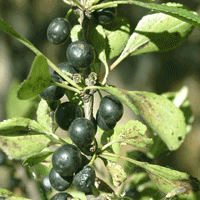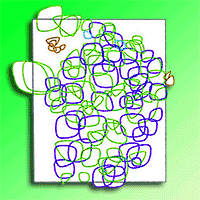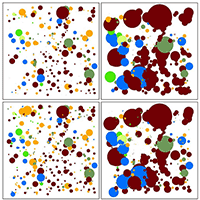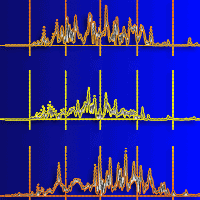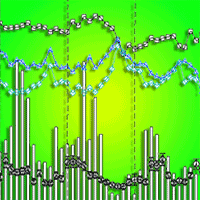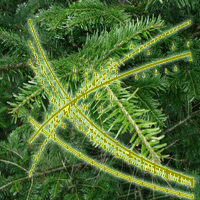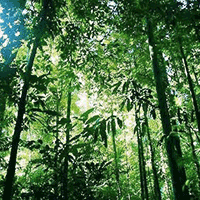When a plant increases resource allocation to reproduction from its limited reserves, the allocation to the other functions is reduced. Because of these trade-offs, differences in reproductive allocation are believed to result in relative differences in life history traits. Dioecious plants provide an excellent opportunity for detecting such possible trade-offs in resource allocation. This study aims to present a finding about the gender-based cost of reproductive allocation. The trade-off between reproduction and foliage biomass was examined at different modular levels (shoot/sub-branch, branch, and shrub/tree level). There were no intra-annual trade-offs between reproduction and foliage biomass in either sex of either species at shoot/sub-branch level, branch level and shrub level. Inter-annual trade-offs were detected in females for both species. Inter-annual trade-offs existed at all three different modular levels in R. schneideri females, while the evidence of inter-annual trade-offs was only detected at branch level in R. davurica females. At the population level, the sex ratio was female-biased in 2010, and it did not significantly deviate from 1:1 in 2011 in R. davurica. However, the sex ratios were significantly female-biased in both 2010 and 2011 in R. schneideri. This study has shown that the degree of autonomy of the different plant organs influenced the trade-offs between reproduction and growth, which suggests a species- and sex-dependent modular autonomy.
Keywords
, , ,
Citation
Wang J, Zhang C, Zhao X, von Gadow K (2014). Reproductive allocation of two dioecious Rhamnus species in temperate forests of northeast China. iForest 7: 25-32. - doi: 10.3832/ifor1020-007
Academic Editor
Roberto Tognetti
Paper history
Received: Apr 24, 2013
Accepted: Aug 02, 2013
First online: Oct 14, 2013
Publication Date: Feb 03, 2014
Publication Time: 2.43 months
© SISEF - The Italian Society of Silviculture and Forest Ecology 2014
Open Access
This article is distributed under the terms of the Creative Commons Attribution-Non Commercial 4.0 International (https://creativecommons.org/licenses/by-nc/4.0/), which permits unrestricted use, distribution, and reproduction in any medium, provided you give appropriate credit to the original author(s) and the source, provide a link to the Creative Commons license, and indicate if changes were made.

Breakdown by View Type
(Waiting for server response...)
Article Usage
Total Article Views: 54184
(from publication date up to now)
Breakdown by View Type
HTML Page Views: 45759
Abstract Page Views: 2626
PDF Downloads: 4302
Citation/Reference Downloads: 17
XML Downloads: 1480
Web Metrics
Days since publication: 4446
Overall contacts: 54184
Avg. contacts per week: 85.31
Article Citations
Article citations are based on data periodically collected from the Clarivate Web of Science web site
(last update: Mar 2025)
Total number of cites (since 2014): 9
Average cites per year: 0.69
Publication Metrics
by Dimensions ©
Articles citing this article
List of the papers citing this article based on CrossRef Cited-by.
(1)
Antos JA, Allen GA (1990)A comparison of reproductive effort in the dioecious shrub
Oemleria cerasiformis using nitrogen, energy and biomass, as currencies. American Midland Naturalist 124: 254-262.
CrossRef |
Gscholar
(2)
Barrett SCH, Pannell JR (1998)Baker’s law revisited: reproductive assurance in a metapopulation. Evolution 52: 657-668.
Online |
Gscholar
(3)
Bazzaz FA, Chiariello NR, Coley PD, Pitelka LF (1987)Allocating resources to reproduction and defense. BioScience 37: 58-67.
CrossRef |
Gscholar
(4)
Bañuelos MJ, Obeso JR (2004)Resource allocation in the dioecious shrub
Rhamnus alpinus: the hidden costs of reproduction. Evolutionary Ecology Research 6: 397-413.
Online |
Gscholar
(5)
Bierzychudek P, Eckhart V (1988)Spatial segregation of the sexes of dioecious plants. American Naturalist 132: 34-43.
CrossRef |
Gscholar
(6)
Cipollini ML, Stiles EW (1991)Costs of reproduction in
Nyssa sylvatica: sexual dimorphism in reproductive frequency and nutrient flux. Oecologia 86:585-593.
CrossRef |
Gscholar
(7)
Cipollini ML, Whigham DF (1994)Sexual dimorphisms and cost of reproduction in the dioecious shrub
Lindera benzoin (Lauraceae). American Journal of Botany 81:65-75.
CrossRef |
Gscholar
(8)
Crawley MJ (2007)The R Book. The R Book. John Wiley and Sons Ltd., Chichester, UK, pp. 877.
Gscholar
(9)
Dawson TE, Bliss LC (1989)Patterns of water use and the tissue water relations in the dioecious shrub,
Salix arctica: the physiological basis for habitat partitioning between the sexes. Oecologia 79: 332-343.
CrossRef |
Gscholar
(10)
Dawson TE, Geber MA (1999)Sexual dimorphism in physiology and morphology. In: “Gender and sexual dimorphism in flowering plants” (Geber MA ed). Springer, Berlin, Germany, pp. 175-215.
Gscholar
(11)
Delph LF, Meagher TR (1995)Sexual dimorphism masks life history trade-off in the dioecious plant Silene latifolia. Ecology 76: 775-785.
CrossRef |
Gscholar
(12)
Delph LF (1999)Sexual dimorphism in live history. In: “Gender and sexual dimorphism in flowering plants” (Geber MA ed) . Springer, Berlin, Germany, pp. 149-173.
Gscholar
(13)
Elmqvist T, Agren J, Tunlid A (1988)Sexual dimorphism and between-year variation in flowering, fruit set and pollinator behavior in a boreal willow. Oikos 53:58-66.
CrossRef |
Gscholar
(14)
Field DL, Pickup M, Barrett SCH (2012)The influence of pollination intensity on fertilization success, progeny sex ratio, and fitness in a wind-pollinated, dioecious plant. International Journal of Plant Science 173: 184-191.
CrossRef |
Gscholar
(15)
Fox JF, Stevens GC (1991)Costs of reproduction in a willow: experimental responses
vs. natural variation. Ecology 72: 1013-1023.
CrossRef |
Gscholar
(16)
Garcia MB, Antor RJ (1995)Sex ratio and sexual dimorphism in the dioecious
Borderea pyrenaica (Dioscoreaceae). Oecologia 101: 59-67.
CrossRef |
Gscholar
(17)
Hamilton WD (1967)Extraordinary sex ratios. Science 156: 477-488.
CrossRef |
Gscholar
(18)
Hasegawa S, Takeda H (2001)Functional specialization of current shoots as a reproductive strategy in Japanese alder (
Alnus hirsute var. sibirica). Canadian Journal of Botany 79:38-48.
CrossRef |
Gscholar
(19)
Henriksson J (2001)Differential shading of branches or whole trees: survival, growth, and reproduction. Oecologia 126: 482-486.
CrossRef |
Gscholar
(20)
Karlsson PS, Méndez M (2005)The resource economy of plant reproduction. In: “Reproductive allocation in plants” (Reekie EG ed). Elsevier Academic Press, Burlington, MS, USA, pp. 1-49.
Gscholar
(21)
Lloyd DG, Webb CJ (1977)Secondary sex characters in plants. Botanical Review 43: 177-216.
CrossRef |
Gscholar
(22)
Lovett Doust J, Lovett Doust L (1988)Modules of production and reproduction in a dioecious clonal shrub,
Rhus typhina. Ecology 69: 741-750.
CrossRef |
Gscholar
(23)
Matsushita M, Nakagawa M, Tomaru N (2011)Sexual differences in year-to-year flowering trends in the dioecious multi-stemmed shrub
Lindera triloba: effects of light and clonal integration. Journal of Ecology 99: 1520-1530.
CrossRef |
Gscholar
(24)
Miyazaki Y, Hiura T, Kato E, Funada R (2002)Allocation of resources to reproduction in
Styrax obassia in a masting year. Annals of Botany 89: 767-772.
CrossRef |
Gscholar
(25)
Munetaka T, Naoto U, Kenji S (2009)Compensatory mechanisms for reproductive costs in the dioecious tree
Salix integra. Botany 87:315-323.
CrossRef |
Gscholar
(26)
Newell EA (1991)Direct and delayed costs of reproduction in
Aesculus californica. Journal of Ecology 79: 365-378.
CrossRef |
Gscholar
(27)
Nicotra AB (1999)Reproductive allocation and the long-term costs of reproduction in
Siparuna grandiflora, a dioecious neotropical shrub. Journal of Ecology 87: 138-149
CrossRef |
Gscholar
(28)
Obeso JR (2002)The costs of reproduction in plants. New Phytologist 155: 321-348.
CrossRef |
Gscholar
(29)
Obeso JR, Álvarez-Santullano M, Retuerto R (1998)Sex-ratios, size distributions, and sexual dimorphism in the dioecious tree
Ilex aquifolium (Aquifoliaceae). American Journal of Botany 85: 1602-1608.
CrossRef |
Gscholar
(30)
Popp JW, Reinartz JA (1988)Sexual dimorphism in biomass allocation and clonal growth of
Xanthoxylum americanum. American Journal of Botany 75: 1732-1741.
CrossRef |
Gscholar
(31)
Rovere AE, Aizen MA, Kitzberger T (2003)Growth and climatic response of male and female trees of
Austrocedrus chilensis, a dioecious conifer from the temperate forests of southern South America. Ecoscience 10: 195-203.
Gscholar
(32)
Sakai AK, Burris TA (1985)Growth in male and female Aspen clones: a twenty-five-year longitudinal study. Ecology 66: 1921-1927.
CrossRef |
Gscholar
(33)
Shelton AO (2010)The origin of female-biased sex ratios in intertidal seagrasses (
Phyllospadix spp.). Ecology 91: 1380-1390.
CrossRef |
Gscholar
(34)
Stehlik I, Barrett SCH (2005)Mechanisms governing sex-ratio variation in dioecious
Rumex nivalis. Evolution 59: 814-825.
CrossRef |
Gscholar
(35)
Taylor DR (1999)Genetics of sex ratio variation among natural populations of a dioecious plant. Evolution 53: 55-62.
CrossRef |
Gscholar
(36)
Tozawa M, Ueno N, Seiwa K (2009)Compensatory mechanisms for reproductive costs in the dioecious tree
Salix integra. Botany 87: 315-323.
CrossRef |
Gscholar
(37)
Ueno N, Kanno H, Seiwa K (2006)Sexual differences in shoot and leaf dynamics in a dioecious tree,
Salix sachalinensis. Canadian Journal of Botany 84: 1852-1859.
CrossRef |
Gscholar
(38)
Vaughton G, Ramsey M (2011)Reproductive allocation and costs in gynodioecious
Leucopogon melaleucoides (Ericaceae): implications for the evolution of gender dimorphism. Plant Biology 13: 888-895.
CrossRef |
Gscholar
(39)
Verdú M, Spanos K, Kanová I, Slobodník B, Paule L (2007)Similar gender dimorphism in the costs of reproduction across the geographic range of
Fraxinus ornus. Annals of Botany 99: 183-191.
CrossRef |
Gscholar
(40)
Willson MF (1983)Plant Reproductive Ecology. Wiley, New York, USA, pp. 291.
Gscholar
(41)
Yu L, Lu J (2011)Does landscape fragmentation influence sex ratio of dioecious plants? A case study of
Pistacia chinensis in the Thousand-Island Lake region of China. PLoS One 6: e22903.
CrossRef |
Gscholar
(42)
Zhang CY, Wang J, Zhao XH, Xia FC, Gadow KV (2011)Sexual dimorphism in reproductive and vegetative allometry for two dioecious
Rhamnus plants in north-eastern China. European Journal of Forest Research 131: 1287-1296.
CrossRef |
Gscholar
